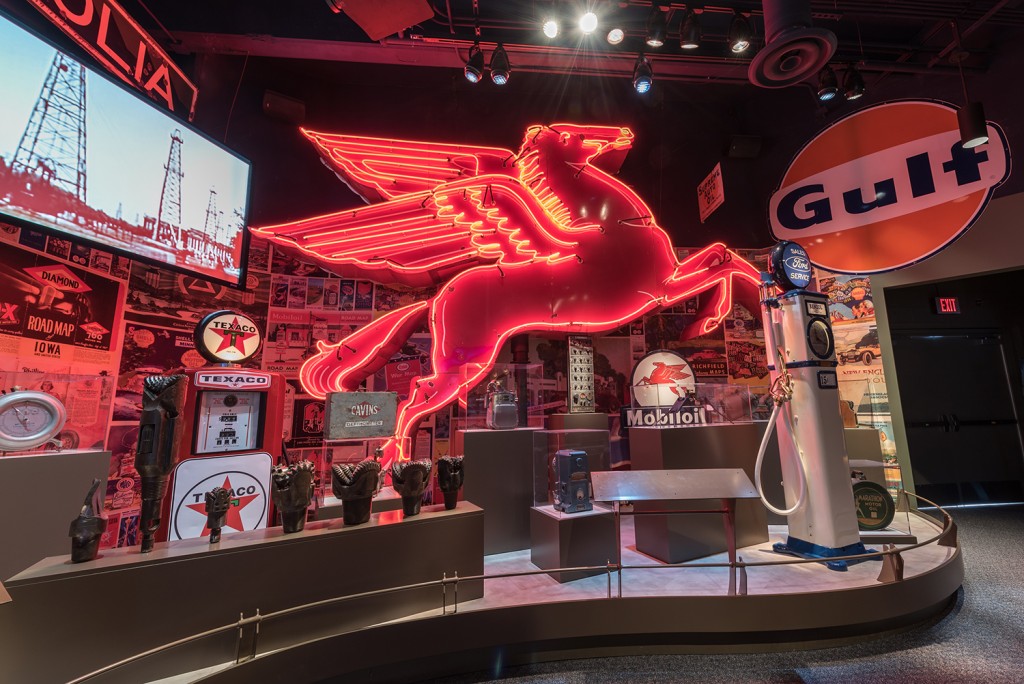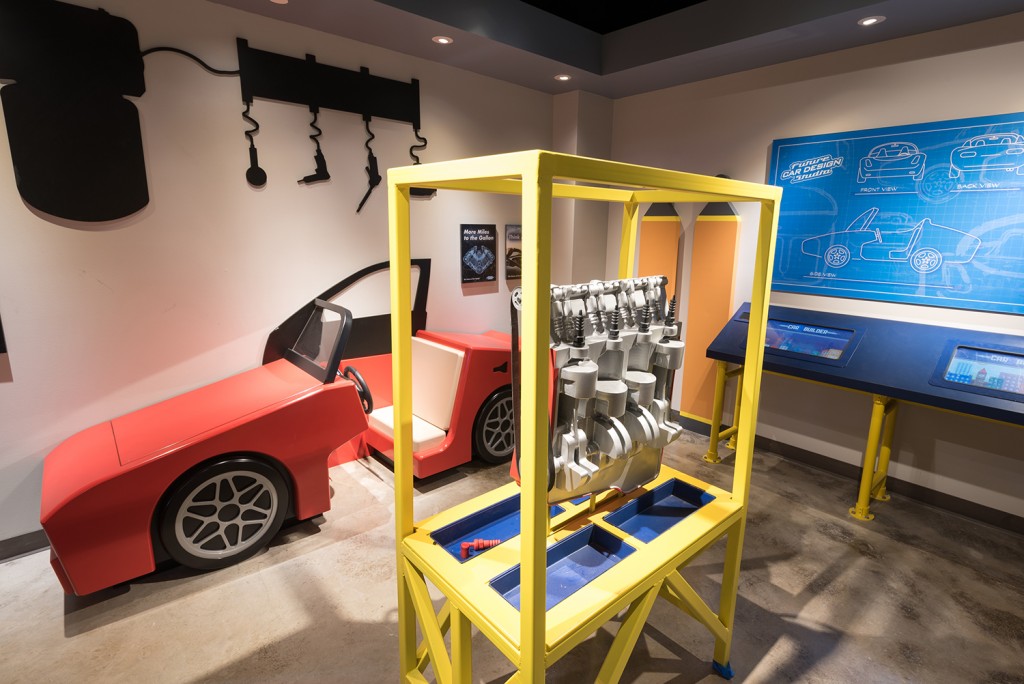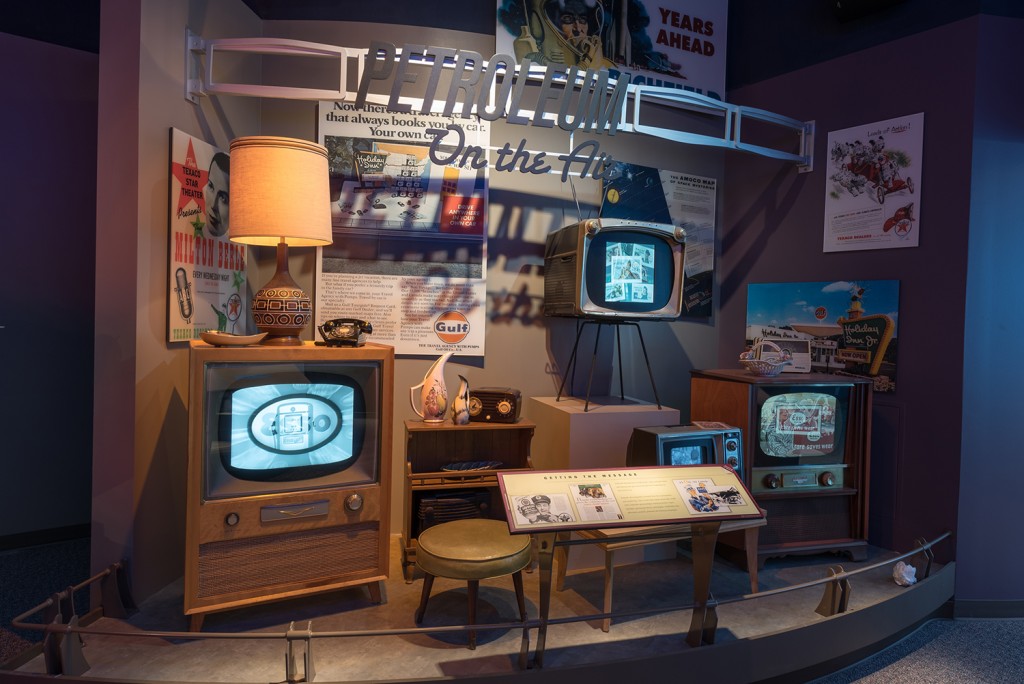The Petroleum Museum renovation is complete, and the results are likely to amaze and delight almost any visitor.
Lana Cunningham
Five. Four. Three. Two. One.
The countdown begins on the clock outside Mythcrackers Theater. Once visitors enter the small theater on the first stop at the newly remodeled Petroleum Museum, the fun begins.
Visitors travel through time as they watch the changing geography that formed the Permian Sea, touch cores from deep inside the earth, play games to find oil (or lose money), hear stories about citizens who impacted the industry, and “take off” in a special vehicle to search for oil and gas.
The Museum, located along Interstate 20 at the southern edge of Midland, celebrated completion of the $18 million renovation with a party on Apr. 2. The new exhibits tell the story of the petroleum industry in an immersive way that captures the attention of people of all ages and learning capability. Visitors can touch exhibits, read stories, and hear information that succinctly explains everything in simple language.
“The original petroleum exhibits for the Museum were completed in 1975 and 1981,” said Kathy Shannon, the museum’s executive director. “So much has changed in both the museum world and in the petroleum industry. It was definitely time to highlight the industry in a new, interactive, and exciting way.”
Jack Rouse Associates was selected as the design firm, and Rob Morgan lead the team as senior project director. A 28-year employee with JRA, Morgan has completed projects that range from Aramco to the current Toyota Visitor Center in Plano.
“Rouse succeeded in telling the story and giving visitors the opportunity to explore and choose their depth of learning,” Shannon said.
JRA is a group of writers, planners, designers, media producers, and project managers based in Cincinnati, Ohio. Named by The Wall Street Journal as “one of the world’s more prominent design firms,” JRA is a multi-disciplinary firm that has been structured to conceive, visualize, and realize unique audience experiences around the globe, according to JRA’s website.
Among the international company’s long list of projects are Texas Wild! at Fort Worth Zoo, Washington Monument Interpretive Center, Guangdong Science Center, Kentucky Derby Museum, The Mind Museum, Cincinnati History Museum, Nashville Zoo, American Classical Music Hall of Fame, and Golisano Children’s Museum of Naples.
“We chose Rouse because of the depth of their team. I believe it was a real team effort, but Rob was the lead,” Shannon said.
“These exhibits are designed for streakers, strollers, and studiers,” said Stacie Hanna, the museum’s Education Director, about the exhibits’ appeal to various types of visitors.
From the days of the earth’s shifting topography millions of years ago to that day’s price for oil and natural gas on the world market, the exhibits cover almost every aspect of the industry. Music, paintings on the wall, and displays of historic objects create a total environment that changes with the story and the exhibits.
By way of a Family Feud-themed video, the audience in Mythcrackers Theater watches a game show where questions are asked about the petroleum industry. Hanna said one set of questions focuses on the criticism that the industry uses an inordinate amount of water. The answer looks at how much water is used by other industries, such as agriculture, as well as the number of gallons that inundate golf courses, in comparison with actual usage by the petroleum industry.
The first stop outside the theater takes the visitor to the Permian Sea. “We asked ourselves, ‘What next?’ when coming out of the Mythcrackers Theater,” Morgan said. Why did the industry spring up here; how did the petroleum get into the ground?
“This is an immersive environment,” Hanna said. “It feels like we are in the sea.” A video shows the shifting ground over the millennia as the earth changed and the Permian Basin was formed. Fossils are embedded into the walls and a column shows the land at the various zones, such as Ellenberger or Wolfcamp.
A revamped Permian Sea diorama, designed by Terry Chase for the Museum when it first opened in 1975, sparkles behind a window. Morgan said the diorama had been tucked behind the Boom Town. “It wasn’t telling the story in the best way. We put it up front and made it the star of the show.”
“Chase cleaned up the diorama and re-worked it, adding some creatures that have been discovered since the Museum first opened,” Hanna said.
A large map on one wall shows the various zones under towns in the Basin, including a fault line, as well as traps and salt domes. “This will be a lot easier to teach when school groups come and to [easier to] explain the geologic time line,” she said.
This section winds into the Birth of the Industry in the Permian Basin, when the economy jumped from cattlemen to wildcatters. The W.H. Abrams No. 1 well blew in on July 20, 1920, at Westbrook and the industry began priming itself for the next major discovery. That came with Santa Rita No. 1 in May 1923, at Texon and the Permian Basin cracked open to the world of oil and gas exploration.
Boom Town gives the visitor a peek into a Land and Title Office and other shops replicated from Midland in the 1920s. “We brought some of the collections out to be displayed in a better way,” Hanna said. An encased gun case is situated outside the General Store, and a dress shop displays the latest styles. A Don Parks painting forms the backdrop for the town and a renovated Dowell truck adds to the décor. Signs show the price of a barrel of oil, a loaf of bread, and a dozen eggs.
Central to Growth of the Nation is Pegasus, nicknamed “Peggy,” the red neon-lighted symbol that flew over the Mobil building in downtown Midland. It was found in a warehouse, repaired, and given a place of honor in the section that deals with 1940s and 1950s. Prices of everyday items take visitors back to that era, along with videos, old TV sets that show advertisements, and antique drilling equipment.
Visitors can then stroll through the 1960s, 1970s, and 1980s when the Organization of Petroleum Exporting Countries was formed and changed the world oil market.
Morgan said that in doing research, his staff uncovered a trail of predictions and prophecies, along with the actual results. As a result, they added the area titled “Peaks and Prophecies” to the design concept.
Hanna showed one of the earliest prophecies: that the U.S. oil supply would be depleted in four years. That was back in the 1800s. With touch screens showing predictions followed by what really happened up to the current day, Hanna suggested that, “With so much information, people could stay here forever.” A timeline on the wall illustrates how Standard Oil started as the only major oil company, and how, over the years, other majors, including ConocoPhillips, ExxonMobil, BP, Shell, and Chevron, joined the fray. A bulletin board allows museum staff to continually post the changing industry predictions. Scrolling across a stock price board are that day’s prices on WTI, natural gas, and Brent crude.
“We had to address a topic that kept coming up—when are we going to run out of oil? What we found is that for over 100 years, since they found oil in Titusville, Pennsylvania, people have been making predictions about the earth’s oil and how long it would last. We wanted to lay out a discussion for the visitors to talk about it. We just laid out some of the premises that people had been talking about for a long time,” said Morgan.
Then comes the really fun hands-on part: a ride on the PetroTrekker. Large enough to hold a classroom of school students, the PetroTrekker sounds a countdown before takeoff. The machine shakes and the riders are off, heading out through the roof of the museum and “flying” through the sky over Midland and into the world to search for oil. The machine can “dive” into oceans to gather data for exploration efforts.
“This is very interactive,” Hanna said. “The floor shakes and blue lights come on when it’s going into the sea. We’re racing against other people to find oil.”
Morgan called the flying machine “whimsical and a theatrical way to help guests understand some of the technology that goes into finding oil. Taking place in the near future, we wanted to get across the idea that these countries are constantly searching for oil and gas, and technology plays a large role in finding those new reserves.”
On the technology side, “One of the first exhibits you encounter looks at oil and gas prices today. When you go to a gas pump and see that price, what does it mean?” Morgan said. “Where does that money go? We get into the description of taxes and the cost of exploration. This dispels some of the myths that the industry is extremely lucrative. Some investments pay off and some don’t. Then, Uncle Sam’s taxes are on top of everything.”
The exhibit titled Tipping Point teaches about demand versus supply, economics of the industry, what countries have located the largest reserves, geology with poles of cores, along with videos and computer games. The seismic exhibit illustrates seismology and its role while giving visitors a sample “shake.”
Risk and Reward lets a visitor choose if he wants to invest in a certain well, watches the drilling, and often has to decide if he wants to continue investing when the drillers hit a problem. One question after another pops up on a computer screen and eventually the game player learns if he is successful or if the money he invested went down the hole.
Another exhibit tackles perforating and fracturing, showing how the operations work.
Not everyone needs to be a geologist or petroleum engineer to work in the industry. A Careers section shows the various interests needed for the many aspects of the industry. Meanwhile, another exhibit highlights supplemental energy that includes hydropower, geothermal, solar, coal, nuclear, and wind.
“We wanted to include this part on other energy and show people how it fits into the puzzle,” Hanna said.
Morgan said his team wanted to address these other energy sources. “Petroleum isn’t the only game in town and will continue to be important for a long time. We know these other forms won’t take the place of the hydrocarbon any time soon.”
For kids of all ages, there is Energy City, with a Car Design Studio where visitors can decide how to build their own car and see if it works.
One of the final exhibits is a video that shows the role of petroleum in everyone’s life. A family is shown at their kitchen table. One item after another disappears until the family is left with grass skirts and a campfire. Petroleum products were a part of everything they had been using, wearing, driving, and playing with.
“Who would have thought that some pharmaceuticals are made of petroleum by-products,” Morgan said. “It’s not just for burning in your car.”
Wrapping up the renovations is the Hall of Inspirations: all the people inducted into the Hall of Fame, with videos about each person.
After 10 years of talking, meeting, planning, seeking funding, and approving designs, Shannon admits she has a difficult time deciding which exhibit she likes best.
“It’s so hard to choose,” she said. “Boom Town is beautiful and historic. Peaks and Prophecies is a wealth of information. PetroTrekker is such a great accomplishment of information and fun. But Energy City, with its child-size activities, is an adventure in itself.
“Each time I walk through the new exhibits, I am fascinated with the amount of information that we were able to weave into the exhibits. The opportunity to have a wonderful permanent home for ‘Peggy’ is such an accomplishment. And to be able to include careers and stories about inspiring people allows us to talk about the industry’s future,” she said.
“One of our goals when we sat down in the beginning and looked at our objectives and what we wanted to do was to make it ‘fun.’ Hopefully, folks will want to continue coming back to see the Museum,” Morgan said.
Five. Four. Three. Two. One. Let the fun begin!
Lana Cunningham is a freelance writer who has lived in Midland since it was a pleasant city of 60,000 people.
It was 10 years in the making, and the final results were worth the wait. The support of the museum’s board of trustees and industry leaders was the ingredient credited with keeping the project pumping instead of shutting it in.
Rob Morgan, senior project director with the design firm Jack Rouse Associates of Cincinnati, Ohio, remembered when the call to work on the Petroleum Museum’s renovation came a decade ago. Then, the 2008-09 financial crisis, later followed by a drop in oil prices, hit and the creative process slowed to a turtle’s pace. But it never stopped.
Museum Executive Director Kathy Shannon praised the board’s continued support with “their dollars, their time, and their expertise. With a 10-year project, sometimes it is difficult to keep a changing board engaged in a project like this. But this museum board supported the project with an unwavering commitment.”
“When we were brought in we spent a lot of time talking to the board, interviewing local people, and talking about how they would envision a new museum experience and what it should be,” Morgan said. “Technology and interactive techniques had changed. Things were out of date and the museum was in need of a facelift.
“We looked at what the new story should be. Our assumption was we would take the good ideas and the exhibits that we would need to keep or re-organize…. We settled on a linear and chronological history of petroleum that would be developed for the lay person,” he continued.
Many people visiting the museum have no idea where oil comes from, how it is brought to the service station, how it is processed, or how pervasive oil is in everyone’s life.
“We set out to tell a complete story,” Morgan said.
The JRA team decided the first step was to “break open a lot of myths people have about the petroleum industry.” Thus was born the Mythcrackers Theater, to set the stage for the rest of the renovations.
“We wanted to set people up for an exploration of the last 300 million years. We did it theatrically and in a game show format. We wanted to have fun with it while addressing some serious concepts.”
The team divided the new exhibit space into two parts. One talks of the industry’s history that starts at development of the Permian Reef and continues until today. The other half explains the science and technology aspects.
“People learn in different ways,” Morgan said. “In the history area you experience the development of the industry and the wildcatters. We tell their stories—the people stories and what happened in the Permian Basin, the spirit of the people who came there early and had the enthusiasm to go after it when they didn’t have the technology. They just had a gut feeling and the spirit that led to so many companies.”
At the end of the renovated space, the team added a kids area, or Energy City. “We felt it was important to have a separate area for young kids. We reiterate some of the themes and they learn about petroleum and how it powers a city. In the garage they can play with fuel efficient machines and design their own vehicles,” Morgan said.
The new exhibits will allow the Petroleum Museum to continue to be a place of both inspiration and education, Shannon said. “With science and technology at the forefront, we can continue to tell the energy story and its impact on all of our lives.”













